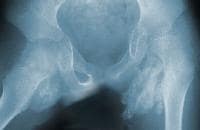n 1918, Dejerine and Ceillier first described heterotopic
ossification (HO) in paraplegic patients injured in World War I,
referring to the process as paraosteoarthropathy. HO has been defined as
the formation of mature lamellar bone in soft tissues. The process
involves true osteoblastic activity and bone formation. HO has been
reported in cases of brain injury, spinal cord injury, poliomyelitis, myelodysplasia, tabes dorsalis, carbon monoxide poisoning, spinal cord tumors, syringomyelia, tetanus, and This condition also has been reported after burns and total hip replacement/joint .
Several terms have been used to describe the condition, including heterotopic ossification, ectopic ossification, and myositis ossificans. HO usually involves the large joints of the body (eg, hips, elbows, shoulders, knees). Excessive bone formation may result in significant disability by severely limiting the range of motion (ROM) of these joints (see image below).
 This
radiograph clearly demonstrates fairly extensive heterotopic
ossification at the bilateral hip regions. The extensive bone formation
shown here makes it easy for the viewer to understand why a patient with
HO could present with complaints such as pain, swelling, palpable mass,
and decreased range of motion. The following 3 categories of HO have been described:
This
radiograph clearly demonstrates fairly extensive heterotopic
ossification at the bilateral hip regions. The extensive bone formation
shown here makes it easy for the viewer to understand why a patient with
HO could present with complaints such as pain, swelling, palpable mass,
and decreased range of motion. The following 3 categories of HO have been described:
Several terms have been used to describe the condition, including heterotopic ossification, ectopic ossification, and myositis ossificans. HO usually involves the large joints of the body (eg, hips, elbows, shoulders, knees). Excessive bone formation may result in significant disability by severely limiting the range of motion (ROM) of these joints (see image below).
 This
radiograph clearly demonstrates fairly extensive heterotopic
ossification at the bilateral hip regions. The extensive bone formation
shown here makes it easy for the viewer to understand why a patient with
HO could present with complaints such as pain, swelling, palpable mass,
and decreased range of motion. The following 3 categories of HO have been described:
This
radiograph clearly demonstrates fairly extensive heterotopic
ossification at the bilateral hip regions. The extensive bone formation
shown here makes it easy for the viewer to understand why a patient with
HO could present with complaints such as pain, swelling, palpable mass,
and decreased range of motion. The following 3 categories of HO have been described:- Myositis ossificans progressiva - This is a rare metabolic bone disease in children with progressive metamorphosis of skeletal muscle to bone; it is characterized by an autosomal dominant pattern of genetic transmission.
- Myositis ossificans circumscripta without Also referred to as neurogenic HO, this is a localized soft-tissue ossification occurring after neurologic injury or burns.
- Traumatic myositis ossificans - This condition occurs from direct injury to the muscles. Fibrous, cartilaginous, and osseous tissues near bone are affected; the muscle may not be involved.
No comments :
Post a Comment